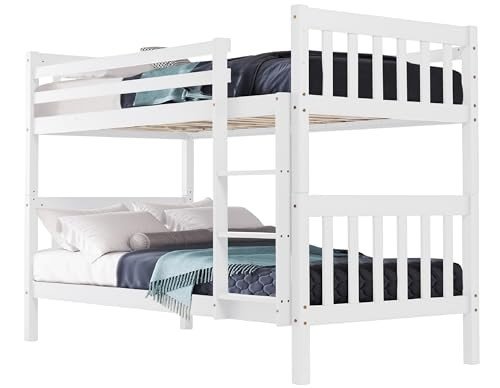A Look Into The Secrets Of Bunk Beds Sale
Bunk Beds Sale: A Comprehensive Guide to Choosing the Right Bunk Bed for Your Home
Bunk beds have long been a staple in kids's bed rooms, offering a mix of space-saving efficiency and fun. Whether accommodating visit site or sisters, buddies on sleepovers, or simply taking full advantage of a playroom, bunk beds have actually become an essential aspect in modern-day household homes. As sales on bunk beds rise, it becomes progressively essential for customers to make informed decisions when purchasing one. This post will cover the essentials of buying a bunk bed, from types to security features, as well as suggestions for preserving the integrity of your investment.
Kinds Of Bunk Beds
When considering a bunk bed sale, it's crucial to understand the different designs available on the marketplace. Below are the most typical types:
Traditional Bunk Beds: These consist of two beds stacked one above the other, sharing a single frame. They are frequently the most affordable choice.
L-Shaped Bunk Beds: This design features one bed positioned vertically and another horizontally. This plan creates extra space beneath the upper bed, which can be utilized for storage or a backyard.
Lofted Beds: Similar to traditional bunk beds but without any lower bed. Instead, the space below can be made use of for a desk, play area, or extra storage.
Triple Bunk Beds: For families with a larger number of kids or regular sleepovers, triple bunk beds supply 3 sleeping areas in a space-efficient design.
Futon Bunk Beds: These styles merge bunk beds and futon sofas. The bottom area transforms into a separate seating location, improving functionality.
Convertible Bunk Beds: These beds can be separated into 2 specific beds, making them versatile as children's needs alter gradually.
Table 1: Comparison of Bunk Bed Types
Type
Description
Space Efficiency
Additional Features
Conventional Bunk Bed
2 beds stacked vertically
High
Most basic design
L-Shaped Bunk Bed
One vertical and one horizontal bed
Moderate
Play or storage space
Lofted Bed
Raised bed with open space below
High
Work/play location
Triple Bunk Bed
Three stacked beds
Really High
Accommodates more users
Futon Bunk Bed
Bunk bed with a convertible futon
High
Multi-functional
Convertible Bunk Bed
Can be split into two separate beds
Moderate
Versatility & & longevity
Security Features to Consider
Security is paramount when purchasing a bunk bed. Below are key safety functions to look for:
Guardrails: Adequate guardrails need to be present on both sides of the upper bunk to prevent falls. They must be at least 5 inches greater than the mattress.
Ladder Design: Look for durable, large ladders with slip-resistant rungs. Make sure that the angle is not too high for easy gain access to.
Stability: Ensure the bed is constructed with strong materials, such as strong wood or sturdy metal. The bed must not wobble when in usage.
Weight Limit: Check the weight capability of the bunk bed to guarantee it can accommodate the intended users safely.
Material Safety: If possible, select beds made from non-toxic products or those fulfilling safety requirements for kids's furniture.
Table 2: Essential Safety Features
Feature
Description
Significance
Guardrails
Sides of upper bed to prevent falls
Necessary for kid safety
Ladder Design
Strong, slip-resistant rungs
Help safe and simple access
Stability
Build quality to prevent wobbling
Ensures security and durability
Weight Limit
Optimum weight capability
Avoids mishaps
Product Safety
Non-toxic, safe materials
Protects children's health
Maintenance Tips for Bunk Beds
To extend the life of your bunk bed and ensure continuous safety, think about the following maintenance suggestions:
Regular Inspections: Periodically examine the structure for loose screws, bolts, or any indications of wear. Tighten fasteners as essential.
Clean Periodically: Dust and clean the surfaces routinely. Use proper cleaners that will not harm the finish.
Check Weight Limits: Be mindful of weight limits, particularly with older kids or adults who might want to use the upper bunk.
Prevent Climbing on Guardrails: Educate children not to utilize guardrails for climbing or playing to decrease the threat of mishaps.
Often Asked Questions (FAQs)
Q1: What is the age limitation for kids to securely utilize bunk beds?A: While it differs by the maker, numerous suggest that children under six must not sleep in the upper bunk due to safety concerns.
Q2: How can moms and dads prevent risky climbing?A: Setting clear rules about bunk bed usage and supervising children can help. Furthermore, utilizing a bed tent can dissuade climbing while creating a fun sleep environment.
Q3: What should I consider when decorating a space with bunk beds?A: Ensure there is enough space around the bunk bed for safe motion, and utilize the decoration to develop individualized spaces for each child.
Q4: Is a lofted bed appropriate for older children?A: Yes, lofted beds can be ideal for older children as long as they meet safety requirements and the child is responsible enough to use them securely.
Bunk beds serve a functional purpose while adding a component of enjoyable to a kid's bedroom. As sales of bunk beds continue to rise, careful consideration of types, security functions, and maintenance practices is important for moms and dads and caretakers. By comprehending these essential elements, families can find the best bunk bed for their home, making sure both practicality and security for years to come. Whether it's for brother or sisters sharing a space or developing a comfortable slumber party space, a well-chosen bunk bed can offer joy and practicality, making it a worthy investment.
